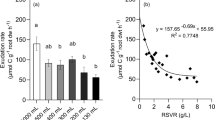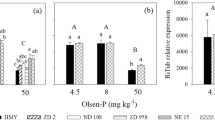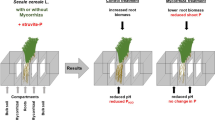Abstract
The double compartment technique has been commonly used in studies on nutrient uptake by mycorrhizas whereas the double pot technique has been used to assess the nutritional stress of plants grown in different soils. A combination of the double pot and the double compartment technique was used as a tool to understand the processes involving mycorrhiza and plant nutrition. Maize (Zea mays) and three species of the arbuscular mycorrhizal fungi in the genus Glomus were used to study phosphorus (P) uptake with and without mycorrhiza from the A and B horizons of an Oxisol. The plants were supplied from the lower pot with a nutrient solution without P. The upper pot had a double compartment with either a fine and coarse mesh screen to control the volume of soil explored by the roots, and thereby, limit the amount of soil P accessible to plants from the test soil. There were significant effects of time for plants grown in both soil horizons, and of mycorrhizas for plants grown in the A soil horizon. No effect of mesh size was observed. There were significant effects of horizon and mycorrhiza, but not of mesh size, on the dry weight and P contents of shoots and roots. The P concentration (P g kg−1 of plant) for shoots and roots was similar in the A and B soil horizons. The results showed that the double pot - double compartment system was suitable for the experimental objectives. No differences in plant growth were observed when root growth was not limited vs root growth limited to the inner compartment because the non-mycorrhizal plants did not take up P. Consequently, responsiveness of the maize cultivar was wholly dependent on mycorrhiza for P uptake under these experimental conditions.
Similar content being viewed by others
References
Boddington C L, Bassett E E, Jakobsen I and Dodd J C 1999 Comparison of techniques for the extraction and quantification of extra-radical mycelium of arbuscular mycorrhizal fungi in soils. Soil Biol. Biochem. 31, 479–482.
Brundrett M, Bougher N, Dell B, Grove T and Malajczuk N 1996 Working with mycorrhizas in forestry and agriculture. Australian Centre for International Agricultural Research, Canberra. 374 pp.
Brunt J 1982 Principles and application of the ‘double pot’ technique for rapid soil testing. Technical Note No 14. Centre for Soil Research, Bogor. 48 pp.
Cardoso I M, Janssen B H, Oenema O and Kuyper T W 2003 Phosphorus pools in Oxisols under shaded and unshaded coffee systems on-farmers' fields in Brazil Agrofor. Syst. 58, 55–64.
De Fillipo B V and Ribeiro A C 1977 Análise química do solo (met-odologia), 2nd ed. Boletim, 29. Imprensa Universitária, Viçosa. 26 pp.
Eissenstat D M, Graham J H, Syvertsen J P and Drouillard D L 1993 Carbon economy of sour orange in relation to mycorrhizal colonization and phosphorus status. Ann. Bot. 71, 1–10.
EMBRAPA 1997 Manual de métodos de análises de solo, 2nd edn. EMBRAPA, Rio de Janeiro. 266 pp.
Helgason T, Merryweather J W, Denison J, Wilson P, Young J P W and Fitter A H 2002 Selectivity and functional diversity in arbuscular mycorrhizas of co-occurring fungi and plants from a temperate deciduous woodland. J. Ecol. 90, 371–384.
Janssen B H 1974 A double pot technique for rapid soil testing. Trop. Agric. 51, 160–166.
Janssen B H 1990 A double-pot technique as a tool in plant nutrition studies. In Plant Nutrition – Physiology and Applications. Ed. M L van Beusichem. pp. 759–763. Kluwer Academic Publishers, Dordrecht.
Koide R T, Goff M D and Dickie I A 2000 Component growth efficiencies of mycorrhizal and nonmycorrhizal plants. New Phytol. 148, 163–168.
Kothari S K, Marschner H and Römheld V 1991 Contribution of the VA mycorrhizal hyphae in acquisition of phosphorus and zinc by maize grown in a calcareous soil. Plant Soil 131, 171–185.
Li X, George E and Marschner H 1991 Extension of the phosphorus depletion zone in VA-mycorrhizal white clover in a calcareous soil. Plant Soil 136, 41–48.
Lopes M A, Magnavaca R, Bahia Filho A F C and Gomes e Gama E 1987 Avaliação de populações de milho e seus cruzamentos para tolerância à toxidez de alumínio em solução nutritive. Pesq. Agropec. Bras. 22, 257–263.
Morton J B, Bentivenga S P and Wheeler W W 1993. Germ plasm in the international collection of arbuscular and vesicular-arbuscular mycorrhizal fungi (INVAM) and procedures for culture development, documentation and storage. Mycotaxon 48, 491–528.
Nunes WA G A 1998 Caracterização física, química, mineralógica, micromorfológica e espectral de alguns solos da Zona da Mata mineira. M. Sci. Dissertation. Universidade Federal de Viçosa. 122 pp.
Rasmussen N, Lloyd D C, Ratcliffe G, Hansen P E and Jakobsen I 2000 31P-NMR for the study of P metabolism and translocation in arbuscular mycorrhizal fungi. Plant Soil 226, 245–253.
Temminghoff E J M, Houba V J G, van Vark W and Gaikhorst G A 2000 Soil and plant analyses. Syllabus. Wageningen University Research Center. Wageningen. 263 pp.
Tiessen H and Moir J O 1993 Characterisation of available P by sequential extraction. In Soil Sampling and Methods of Analysis. Ed. M R Carter. pp. 75–86. Canadian Society of Soil Science, Lewis Publishers, Boca Raton.
Van der Heijden E W and Kuyper T W 2001 Laboratory experiments imply the conditionality of mycorrhizal benefits for Salix repens: Role of pH and nitrogen-to-phosphorus ratio. Plant Soil 228, 275–290.
Van der Heijden E W and Kuyper T W 2003 Ecological strategies of ectomycorrhizal fungi of Salix repens: root manipulation versus root replacement. Oikos 103, 668–680.
Van der Heijden MG A 2001 Ecological significance of mycorrhizal diversity: on the role of arbuscular mycorrhizal fungi as a determinant of plant community structure and diversity. Ph. D. thesis, University of Basel.
Van der Heijden M G A 2002 Arbuscular mycorrhizal fungi as a determinant of plant diversity: in search for underlying mechanisms and general principles. In Mycorrhizal ecology. Eds. M G A Van der Heijden and I R Sanders. pp. 243–265. Springer Verlag, Berlin.
Author information
Authors and Affiliations
Rights and permissions
About this article
Cite this article
Cardoso, I.M., Boddington, C.L., Janssen, B.H. et al. Double pot and double compartment: Integrating two approaches to study nutrient uptake by arbuscular mycorrhizal fungi. Plant and Soil 260, 301–310 (2004). https://doi.org/10.1023/B:PLSO.0000030180.95607.0b
Issue Date:
DOI: https://doi.org/10.1023/B:PLSO.0000030180.95607.0b




